

| Wind Power |


| Wind Power |
Jens H. Larsen, M.Eng, Copenhagen Environment and Energy Office
Wind power is the renewable energy source which has gained the largest commercial utilization in Denmark. At the beginning of 1992 there are thus erected appr. 3230 wind turbines in Denmark, and these turbines generate appr. 2.5% of our tote] electricity consumption.
This chapter aims at, giving an idea of the development of grid-connected wind turbines in Denmark, and some facts about this development. Finally the author gives his view on the current situation according wind power.
History
At the beginning of this century windmills were commonly used in Denmark. In 1920 appr. 30,000 windmills were in operation at Danish farms. It were the so called canvas flaps windmills and wind wheels, which mainly supplied tractive power directly to the agricultural machines /1/.
Along with the energy shortage during and after World War II, interest in utilizing wind power appeared again. This development reached its peak, when the power utilities erected the 200 kW Gedser Turbine in 1957. The Gedser Turbine was in operation for 10 years without serious technical problems, and was stopped, because it was uneconomic to operate. During our generation's energy crisis in 1972-74, exactly the Gedser
Turbine became the model for design of the Danish wind turbine concept. See further the section Facts on Wind Turbines.
The energy crisis in 1974 initiated design of smaller household wind turbines. The development began at grassroots level, and with many inventors and pioneers involved. The motives were many, and to great extend characterized by idealism and the debate on introducing nuclear power in Denmark. The first commercial wind turbine was sold in 1976. The motive power was from the beginning, and many years in the future, the private sector, with strong roots in the popular energy movement, folk high schools, etc. In figure 9.1 some of the highlights from this development are collected, which are briefly commented in the following.
From 1976 to 1985 it was mainly the private sector that established wind turbines in Denmark. The turbines were either single ownership or joint ownership installations. Joint ownership wind turbines were established by wind turbine cooperatives.
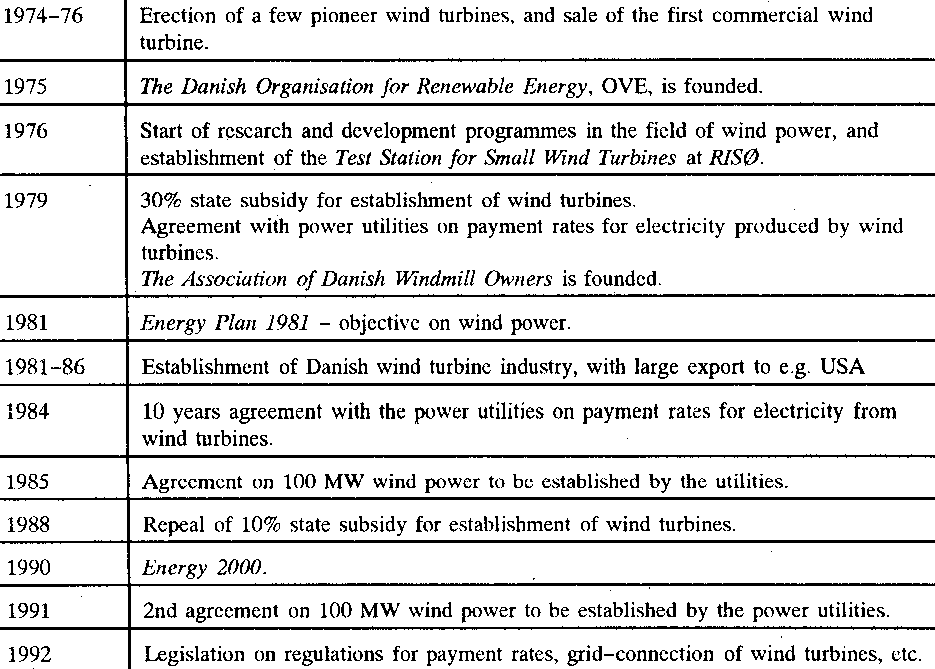
Some turbines were not connected to the grid at the beginning, but today all commercial wind turbines are grid-connected.
From the early 80es the size of the turbines grew from 55 kW, until today (1992) where the mean size of established wind turbines is 200 kW. Today Danish wind turbine manufacturers produce commercial turbines up to 500 kW. See the survey of Danish turbines in appendix 3.
From 1985-92 both private persons and the power utilities established wind turbines. Against a background of a political deal between the government and the social democrats in 1985, the power utilities were enjoined to establish wind turbines. In 1991 the power utilities were asked to establish another 100 MW wind power. Today appr. 75% of all Danish wind turbines are privately owned, and only 25% are owned by the power utilities.
A fundamental feature of the Danish development has thus been the involvement of the private sector. An essential factor in the first stage was 30% state subsidy for establishment of private owned wind turbines. This support was given to the buyer of the wind turbine, thus supporting a private market for wind turbines. Compared to other countries this kind of subsidy has shown to be more efficient in initiating a technological and mercantile development of wind power. The wind turbine manufacturers thus have been able to develop bigger and more efficient machines all the time, while sale to a quite stable home-market has been secured.
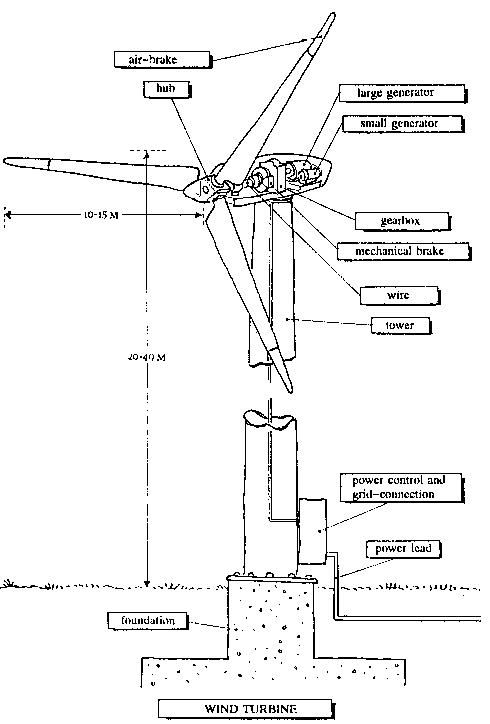
An important basis for the establishment of private wind turbines has been agreements on payment rates for electricity produced by grid-connected wind turbines. A 10 years agreement was contracted by private turbine owners and the power utilities. But this agreement was dropped by the power utilities in 1992, and has subsequently been replaced by legislation in the field.
Together with the state subsidy for establishment of wind turbines, private turbine owners got the electricity tax repaid. Fixed payment rates and tax repayment have been the financial basis, and secured reasonable private economy when establishing wind turbines.
Facts on Wind Turbines
The main parts of a typical Danish wind turbine are shown i figure 9.2. This type is called a three-bladed swift runner. If the blades are fixed, the wind turbine is stall regulated. It means that the wind turbine limits its own maximum performance by a fixed number of revolutions. Some turbines, e.g. Vestas, have revolving blades. This gives a slightly better utilization of the wind, up to 8 %. The rotation of the blades is multiplied through a gearbox to an asynchronous motor. Some wind turbines can be coupled to two different generators (for the better utilization of wind). The size of the generator is often used to name the size of the wind turbine. A better name is in fact the rotor swept area, as the production of the wind turbine mainly depends on the swept area. The turbine is regulated by a fully automatic control. Often the turbine is remote-controlled, and operational data are collected through the telephone network.
Figure 9.3 shows the increase in wind turbine size and production, 1980-89. In 1992 450 kW turbines were erected, with a rotor diameter of 35 m, a height of 35 m, and an annual production of 900,000 kWh, which equals the consumption of 250 households in Denmark.
Development in Rotor Swept Area Efficiency
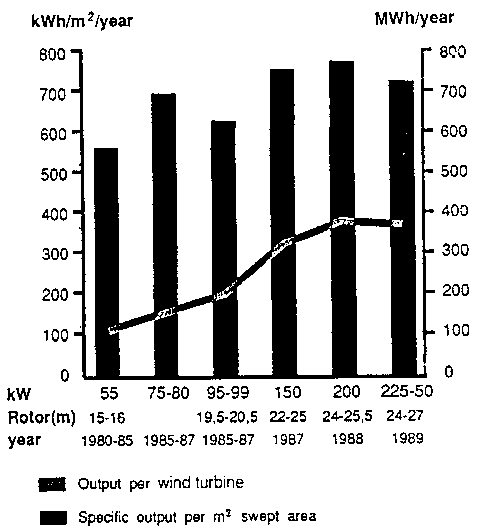
In 1991 the total power production from 3230 wind turbines was appr. 800,000,000 kWh, equal to 2.5% of the total power production in Denmark. ID 1991 the total installed wind power capacity was 410 MW. In the list of established wind turbines 198991 (figure 9.4) appears the distribution on ownership. It shows that single ownership and joint ownership wind turbines are the majority. On figure 9.5 is shown, how the single and joint ownership installations are connected to the grid.
A large number of Danish wind turbines are erected as single standing turbines. Gradually many wind turbine clusters and windfarms have been established. In Denmark a windfarm is defined as a group of more than 5 wind turbines.
Wind Energy
Figure 9.6 shows the mean wind speeds in Europe. Obviously Denmark has good wind conditions, especially in the western part of the country.
In order to calculate the production from a wind turbine on a certain location, it is necessary to know the landscape around it. The landscape can be divided into roughness classes. The less obstacles the more windy the landscape is. Trees, farms, forests, and cities slow the wind down. The relative energy content for different topographic conditions is shown in figure 9.7. It shows that wind energy has its maximum at sea, where no obstacles decelerate the wind. In Denmark the main wind directions are west, southwest, and south. More than 50% of the wind energy comes from these directions. A good wind turbine site in Denmark is thus a south or a west coast. Wind comes with strong power from the sea, and reaches the wind turbine without being hindered by topographic roughnesses.
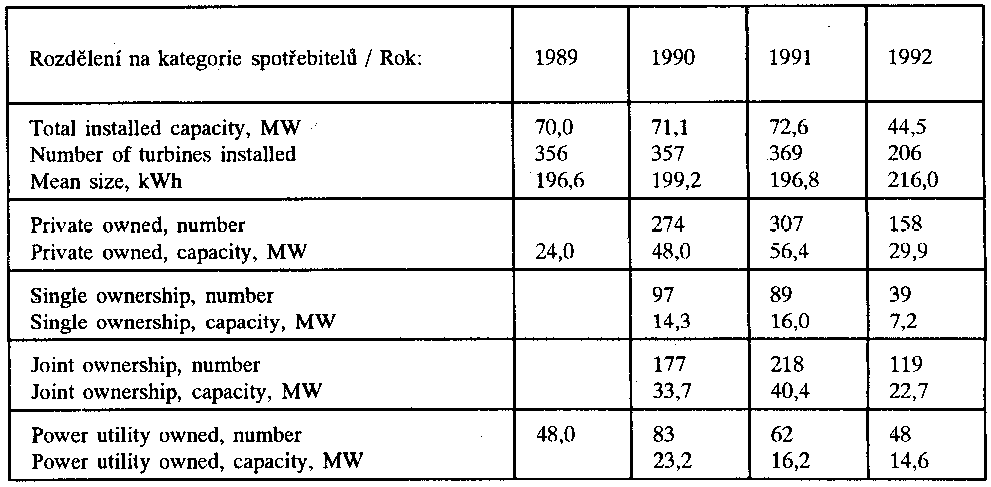
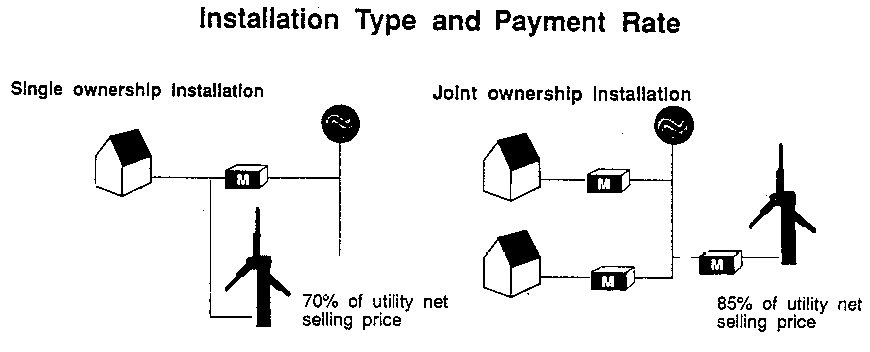
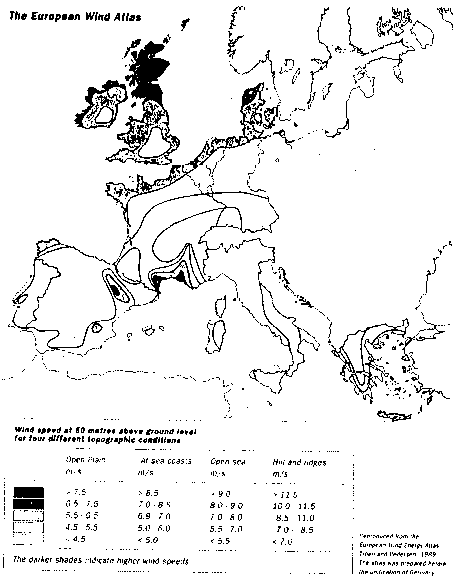
A good wind turbine site in Denmark is in roughness class 1. At such a site a 250 kW wind turbine is able to produce 630,000 kWh/year. An inland site in Denmark will often be of roughness class 2. Here a 250 kW wind turbine can produce 500,000 kWh/year, which is 20% less than in roughness class 1. The experiences from Danish wind turbine projects show, that under existing economical circumstances it is profitable for private persons to erect wind turbines in a roughness class 2. If the construction conditions are favourable, slightly worse wind conditions - roughness class 2.2 - are acceptable. If the wind conditions are
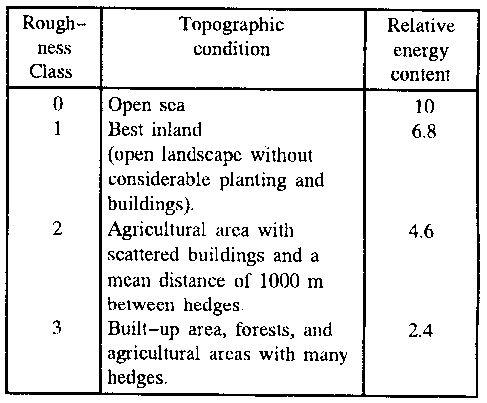
The wind conditions in Denmark are carefully mapped nowadays. there are maps for each region showing where, and how windy the individual sites are /6/.
Wind Turbine Cooperatives
The main force behind the wind turbine development in Denmark has been the initiative and involvement from the private sector. Without this popular involvement, wind power would never have developed to the stage of today. Denmark would probably have been at the same level as other European countries, which are only to establish wind turbines now. To understand this, it is necessary to know some of the background, and the conditions under which the wind turbine cooperatives have emerged.
As mentioned 75% of the Danish wind turbines are privately owned. The private wind turbines are either under single ownership or joint owned by a wind turbine cooperative. The main part, which means 60-75% of the private turbines, are joint ownerships.
The concept of the wind turbine cooperatives historically originates from the Danish cooperative movement. It was, and is, natural to join together in a local area, to solve a joint task. At the same time installation of wind turbines was encouraged by political initiatives and regulations in the wind turbine field. In the beginning a typical wind turbine involved 5-50 families, who joined together to establish a local wind turbine. Gradually, as the turbine size increased, the wind turbine cooperatives grew as well, and have established wind farms with 10-30 wind turbines.
Two main regulations have regulated the joint ownership installations:
address criteria
consumption criteria
The address criteria was originally made, because there was a wish for local connection between the turbine owners and the wind turbines. Thus, there was no political wish, that financially strong individuals were allowed to invest in wind turbines far from their home. Today the address criteria says that, people can buy shares of a wind turbine, which is placed in the municipality where the), live, or in the neighbouring municipality, (it has been changed several times during the last 10 years). The idea reflects that people who live close to the wind turbine, and live with any inconveniences, also shall get any advantages.
The consumption criteria says that, one can only buy wind turbine shares corresponding to 150% of own electricity consumption. Though everybody can own shares corresponding to an annual power production of 9,000 kWh, regardless of the private electricity consumption. Thus it is impossible to speculate in wind turbines, as the possibilities of investments are limited. The regulation is partly introduced, because the turbine owners get the electricity and CO2 tax refunded from the state.
The wind turbine cooperatives are organised as partnerships. This way of organizing has been necessary, because the authorities demand it, if the wind turbine cooperative wants tax exemption. As tax exemption is a condition for the rentability of a wind turbine, this way of organizing is the only one used nowadays. Partnership has the big drawback, that the partners have joint and several liability. This means that each member of the cooperative is personally 100% liable for any debts of the wind turbine cooperative. This has kept many people from participating in a wind turbine cooperative, and does not harmonize with the original Danish cooperative idea.
Private Wind Turbine Economy
The private financial circumstances depend on several factors: installation investment, operation and maintenance costs, annual power production, and payment rates for produced electricity. Typical examples of these costs and income are shown in figure 9.8.
The price of a wind turbine share is often calculated as installation investment divided by annual power production (in MWh).
It can be put like this, the share price is the investment needed when establishing the turbine. to get the annual power production of 1000 kWh. If one wishes to have the costs in DKK/kWh the following figures should be divided by 1000.
Figure 9.8 also shows an example of firs' years account for a wind turbine share, and the simple pay back period, according to two kinds of turbines. The reason why the larger 400 kW turbine has a longer pay back period, can be explained as, this kind of turbine is still new, and therefore not economically optimum yet. Up to now the tendency has been, improved financial conditions for the larger turbines. Within the coming years it is expected that the most profitable turbine size will be about 500 kW.
Many private wind turbine owners have financed their investment by taking a loan. The example shows that the turbine owner will get a small profit of 105 DKK/year per share after repayment on loan.
The key figures in figure 9.8 correspond to the actual financial circumstances, many Danish turbine owners have experienced within the last years. It should be mentioned that single ownership turbines in general have had worse financial circumstances, as well as turbines located at not so windy sites, or overtaken by breakdowns and damages.
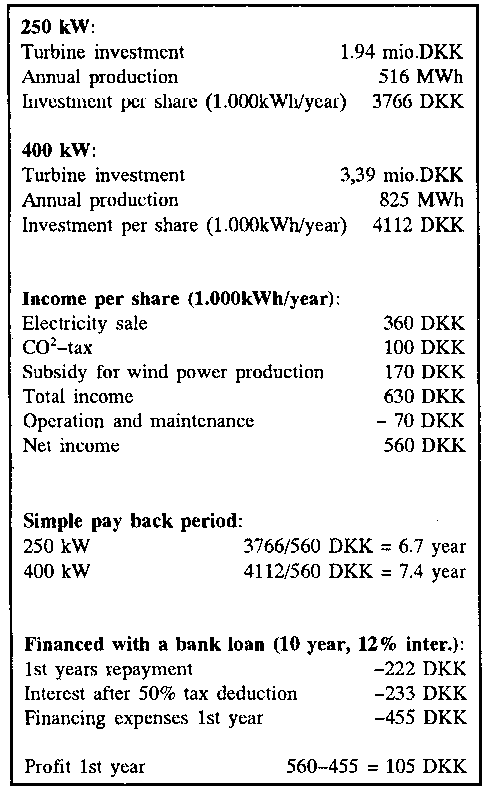
Environment
The electricity produced by wind turbines in Denmark, should alternatively have been produced by a thermal power plant using fossil fuels, thus polluting with carbon monoxide, sulphur, nitrogen oxides, dust, cinders, etc. Of course energy and resources have been spent to produce the wind turbines, but from then on the wind turbine produces energy without polluting. The energy pay back period is less than half a year for a good located wind turbine (chapter 4). Thus wind power must be characterized as one of the cleanest power production methods today.
However establishment of wind turbines is not totally without environmental impact. Impacts as noise, visual effects, and safety are considered here. The visual impact of wind turbines in the Danish landscape may be seen as an environmental problem. Due to the increasing number of wind turbines in Denmark, this view has often been stated during the last years. This is to a great extent a subjective question, which will not be further discussed here. The safety level of Danish wind turbines are high, and accidents with serious consequences are rare.
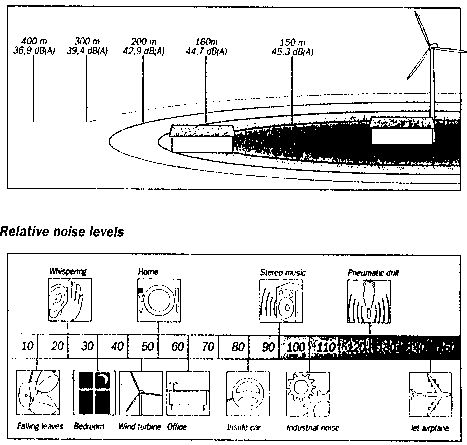
The main environmental problem concerning wind turbines is their noise. In Denmark we have environmental legislation, which regulates how much noise a wind turbine is allowed to emit' and which noise level the neighbours must be exposed to. Figure 9.9 shows the noise level around a wind turbine. It shows that a single standing wind turbine can be placed appr. 150 m from the nearest housing, and still keep a maximum noise level of 45 dB(A). For larger estates the noise limit is 40 dB(A), which leads to a minimum distance of 250 m.
The Present Situation for Wind Power in Denmark
It must be said that Denmark is leading in utilization of wind power, and has many years of practical experience with establishment of wind turbines. In other words, we are 5-10 years ahead from the point where the other European countries are starting now. That is why our experiences can support the development in other countries. And if our experiences are used right, other countries might be able to avoid some of the problems we had in Denmark. The fields I feel relevant to address in the following are:
popular involvement
conflicts with the established power supply
planning in the wind power field
off shore wind turbines
Popular involvement
The importance of popular involvement appears from the previous paragraph. As mentioned, the majority of Danish wind turbines are erected by private people. This development has continued in the last years, and will probably also be an important factor in the future. The development has spread dike rings in the water, as existing wind cooperatives have helped new wind projects to get started. This development has been strongly supported by E;nergy Offices and advisers from the Association of Danish Windmill Owners. In other words, it has been possible to lean on a well-developed network of persons and institutions, which have stood together to solve the problems, and force the development. However, there are also tendencies, that the level of popular involvement can not be kept without renewed and continued efforts. The following problems can be mentioned: - it has become more difficult to find a good wind turbine location, without conflicts with landscape considerations, etc.
long authority hearing hinders new projects
many interested are already partners in a wind turbine, and new persons, who want to start a wind turbine, become harder to find.
Conflicts with the established energy supply
In spite of a stable development of wind power, the development has always been marked by conflicts with the existing energy supply system. Especially conflicts with the power utilities have influenced the development. Here can be mentioned: payment rates, technical demands on grid-connection of wind turbines, disagreement on how big wind power share can be adopted by the power system, etc. Some of these problems are partly solved through a law adopted in 1992. But not all the conflicts are solved, and the continuing obstacles may unfortunately be expected to reduce the expansion also in the future.
Planning in the wind power field
Until a few years ago only energy planning was relevant according to wind turbines. While the number of wind turbines has increased, physical planning at all levels has been involved. Now counties and municipalities make plans of, where wind turbines can be - and especially can not be placed in Denmark. Different valuations can be made according this development, but in total one can be worried about, if the planning secures installation of enough wind turbines in the future. The official Danish energy plan, E;nergy 2000, assumes that in the year 2000, 10% of the Danish electricity consumption is supplied by wind turbines. This has to be seen in relation to the survey of wind resources in Denmark, which shows that in case wind turbines were installed at all the best wind sites, then we could cover 80% of our electricity consumption by wind energy.
From our point of view the minimum goal is to cover 10% with wind energy. OVE (the Danish Organization for Renewable Energy) has published an action plan on renewable energy, which shows a goal of 25% covering of the electricity consumption.
Off shore wind turbines
In East Denmark, near Vindeby north of Lolland, the first Danish off shore wind farm was established in 1991. The windfarm has been relatively expensive, and belongs to the power utilities. Some wind turbine cooperatives, e.g. Aarhus Bay Wind Turbine Cooperative, have applied for permission to establish off shore wind farms. The project in Aarhus Bay shows good financial conditions (equal to a good inland location), but until now they have not succeeded in getting the permission to start the project. The Ministry of Energy is not interested in, that a private wind turbine cooperative gets involved in off shore wind turbines. This is a block of the development, as we have earlier seen, that good demonstration projects are needed, before a break through is possible.
Small-scale and Stand-alone Windmills
The small household turbines started the development in the 70es. These were later developed to the larger grid-connected wind turbines, and the improvement of the small and not-grid-connected wind turbines more or less stopped. Anyway, in the last years a new interest has appeared in utilizing and developing smaller turbines for alternative purposes.
The various existing types can be parted in:
small battery charging turbines (0-1 kW)
smaller wind turbines (1-20 kW), grid connected and stand-alone
heat producing windmills
water pumping windmills
third world applications wind-diesel plants
The two first categories (small battery charging turbines, and small wind turbines rating 1-20 kW) are named household turbines or just small turbines.
The technology of small turbines can be quite simple, demanding little maintenance. Typically the blades are fixed with simple air brakes in the tips, and maybe mounted directly on the generator shaft.
Some of the small wind turbines have a Permanent
Magnet Generator (PMG), and therefore with a simple control are able to produce electricity independent of the grid. The interest in these small turbines has grown, but there is no market for them in Denmark. But some manufacturers sell small turbines. In appendix 3 there is a survey of the small turbines.
The last four types are mentioned to give an overview, but will not be further described.
Literature
Energihandbogen (The Energy Handbook), Judith Winther et al. OVEs Forlag, 1981.
Vedvarende Energi i Danmark (Renewable Energy in Denmark), Jan Viegand et.al. Physical Laboratory 111, DtH, 1990.
Wind Power in the 90es - Pure [Energy. FDV, The Association of Danish Windmill Manufacturers, 1991.
Information from Annual meeting 1992 in FDV.
Wind Energy in Denmark - Research and technological Development. The Danish Energy Agency, 1990.
Kortloegning af vindenergi i Danmark (Survey of Wind Energy in Denmark). The Danish Energy Agency and Nellemann Consulting Engineers, 1991.
Privatejede vindmollers okonomi (Private-owned Wind Turbine Economy). The Danish Energy Agency, June 1991.

